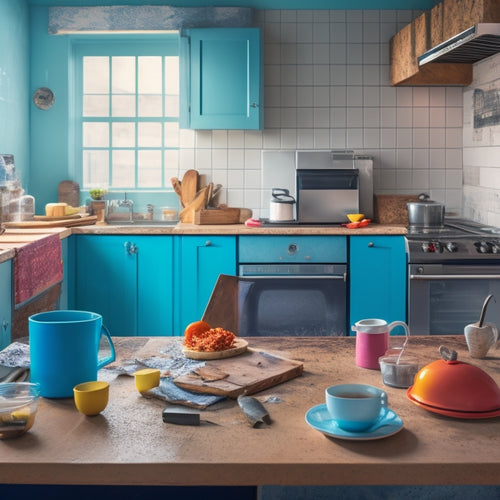
Streamline Your Space: Efficient Home Systems
Share
You're already surrounded by the tools and spaces you need to live more efficiently, but they're being held back by clutter, disorganization, and inefficient systems. Start by adopting a minimalist mindset, letting go of non-essential items and implementing donation strategies. Divide your home into distinct zones, like the kitchen and home office, and organize each zone separately. Employ hidden storage areas, invest in multi-purpose furniture, and create wall niches to maximize storage solutions. By streamlining your kitchen workflow, creating a maintenance routine, and establishing daily tasks, you'll be well on your way to an efficiently organized home, and there's still more to uncover to take your space to the next level.
Key Takeaways
- Adopt a minimalist mindset to declutter and organize your space efficiently by letting go of non-essential items.
- Divide your home into distinct zones and organize each zone separately for efficient management and maintenance.
- Utilize hidden storage areas, multi-purpose furniture, and decorative boxes to maximize storage solutions and maintain aesthetics.
- Establish routines for daily task management, seasonal deep cleaning, and scheduled inspections to ensure home safety and efficiency.
- Prioritize items based on importance and usefulness, and implement strategies for donation and removal of unwanted items to maintain organization.
Decluttering for a Fresh Start
Since you're enthusiastic to create an efficient home system, begin by tackling the physical and mental clutter that's holding you back.
Adopt a minimalist mindset by letting go of items that no longer serve a purpose or bring you joy. Overcome emotional attachment by acknowledging the memories, not the items themselves. To shift your mindset, recognize that possessions don't define personal identity and focus on value-adding items.
Implement donation strategies, such as scheduling regular pickup or drop-off times. Don't forget digital decluttering, like organizing computer files and deleting unnecessary emails, and maintain good habits for ongoing digital organization.
Evaluate each space, identifying areas that require the most attention. Involve your family in the process to instill a sense of responsibility and teamwork.
Zone-Based Organizing Strategies
You're ready to take your organizing to the next level with zone-based strategies.
You can implement a zone segmentation strategy by dividing your home into areas like "kitchen zone" or "home office zone", and then focus on organizing each zone separately.
Alternatively, you can declutter by category, gathering all similar items from around the house, such as all cleaning supplies or all books, and then assigning a home for each category.
Zone Segmentation Strategy
A zone segmentation strategy involves dividing your home into distinct zones, each with its own specific purpose or function. This approach helps you allocate space effectively, making the most of your available area.
By identifying the room purpose and activity zones, you can categorize your space into sections like relaxation, entertainment, work, and storage. For instance, your living room might be an entertainment zone, while your home office is a work zone.
Decluttering by Category
Every zone in your home contains a unique set of items, each serving a specific purpose. To declutter effectively, categorize items into clutter categories, such as "keep," "donate," and "recycle."
Implement a sorting system to streamline the process. When evaluating items, consider your emotional attachment and adopt a minimalist mindset. Ask yourself, "Do I really need this?"
Prioritize items based on their importance and usefulness. Involve your family in the process to guarantee everyone is on the same page.
As you sort, identify items for donation and develop a strategy for their removal. By decluttering by category, you'll efficiently evaluate your space, prioritize items, and create a more organized home.
Maximizing Vertical Storage Space
Vertical spaces in your home, from floor to ceiling, hold immense potential for storage. By maximizing this often-wasted space, you can create a more organized and clutter-free living area.
Here's how:
-
Use shelf organization systems to store books, decorative items, and infrequently used kitchen gadgets.
-
Hang wall decor, such as art or mirrors, to add visual interest while keeping walls clear for storage.
-
Install storage bins or baskets to store items like linens, cleaning supplies, or toys.
-
Invest in multi-purpose furniture with built-in storage, like an ottoman or coffee table with shelves.
-
Employ pegboards for hanging items like bikes, tools, or accessories, and consider installing a ladder for easy access to high shelves or ceiling storage.
Streamlining Your Kitchen Workflow
Your kitchen is the heartbeat of your home, where meals are crafted, and memories are made. To optimize kitchen workflow, start by organizing your kitchen tools and utensils, keeping frequently used items within easy reach.
Implement a meal prep routine to reduce cooking time and increase efficiency. Guarantee countertop organization by designating zones for food preparation, cooking, and cleanup.
Conduct a pantry inventory to eliminate expired or unused items, and implement a "first in, first out" system. Strategically place appliances to minimize walking distances and maximize cooking efficiency.
Employ recipe management tools, such as a meal planning app, to streamline food storage and reduce waste. Encourage family involvement in meal planning and prep to promote a sense of teamwork and responsibility.
Creating a Maintenance Routine
You'll want to establish a routine that covers daily task management to keep your home tidy, seasonal deep cleaning to tackle stubborn grime, and scheduled inspections to identify potential issues before they become major problems.
By incorporating these habits into your daily and seasonal schedules, you'll be able to maintain your home's efficiency and prevent costly repairs.
Start by identifying the tasks that need to be done regularly and allocate specific times for each one.
Daily Task Management
Every homeowner has numerous tasks to tackle daily to maintain their living space efficiently. To stay on top of these tasks, it's vital to develop a daily task management system. This system should include task prioritization techniques to guarantee you're focusing on the most critical tasks first.
Digital task tools, such as apps or calendars, can help you stay organized and on track.
Here are some tasks to take into account including in your daily routine:
- Morning routine: Make your bed, put away dishes, and prep for the day
- Quick pick-ups: Take a few minutes to tidy up living areas and put away clutter
- Meal prep: Plan and prepare meals for the day or week
- Laundry and cleaning: Set aside time for laundry, cleaning, and disinfecting high-touch areas
- Review and adjust: Take a few minutes to review your tasks and adjust your schedule as needed
Seasonal Deep Cleaning
Organization is the backbone of a well-maintained home, and a seasonal deep cleaning routine is crucial to keeping your living space in top condition. By setting aside dedicated time for spring cleaning, holiday prep, and clutter rotation, you'll reduce allergens and maintain a sense of control over your environment.
| Season | Task |
|---|---|
| Spring | Deep clean carpets, dust ceiling fans, and organize closets |
| Summer | Clean out the fridge, freezer, and oven; tidy up outdoor spaces |
| Fall | Prepare for holiday hosting by decluttering and organizing entertaining areas |
| Winter | Focus on allergen reduction by dusting and vacuuming frequently |
Create cleaning checklists customized to each season to guarantee your home stays in top shape. By incorporating seasonal organization into your routine, you'll enjoy a more peaceful and organized living space.
Scheduled Inspections
Now that your home is sparkling clean, it's time to think about maintaining that hard-won cleanliness and organization.
Creating a maintenance routine is essential to guarantee your home remains efficient and safe. Scheduled inspections are a critical part of preventive maintenance, allowing you to catch potential issues before they become major problems.
- Create an inspection checklist to evaluate your home's systems, including HVAC, plumbing, and electrical
- Schedule routine checks to verify safety compliance and identify areas for efficiency upgrades
- Consider hiring professionals for assessments, especially for complex systems like septic or solar panels
- Set scheduling notifications to stay on track and avoid forgotten inspections
- Use these evaluations to prioritize system upgrades and repairs, guaranteeing your home remains in top condition
Utilizing Hidden Storage Areas
By incorporating hidden storage areas into your home's design, you can create a more streamlined and organized living space.
Employ under bed storage bins to stash out-of-season clothing or linens, and install concealed cabinets to hide clutter-prone areas like kitchen utensils or cleaning supplies.
Don't forget to maximize your attic's potential with organization systems customized to your needs.
Invest in multi-purpose furniture with built-in storage, such as an ottoman or coffee table with hidden compartments.
Wall niches can also provide a discreet spot for decorative items or personal treasures.
Finally, optimize your closet space with custom organizers and shelving to keep your wardrobe neatly tucked away.
With these strategies, you'll be well on your way to a clutter-free home that exudes control and sophistication.
Effortless Laundry Room Solutions
As you streamline your storage spaces, don't overlook the laundry room, where clutter and chaos can quickly accumulate. A well-organized laundry room can save you time and energy.
To achieve effortless laundry room solutions, consider these essentials:
-
Implement laundry basket organization by assigning a designated spot for each family member's clothes.
-
Set up a folding station efficiency with a built-in countertop and storage for laundry supplies.
-
Install shelves or cabinets for storing detergent, fabric softener, and other essentials.
-
Employ a hanging organizer for delicates or items that require special care.
-
Invest in a laundry sorter to separate lights and darks, making the washing process more efficient.
Frequently Asked Questions
How Do I Maintain Organization Habits When Living With Clutter-Prone Family Members?
You'll maintain organization habits with clutter-prone family members by establishing clear communication strategies, assigning shared responsibilities, and setting boundaries, ensuring everyone's on the same page and working together to keep your space organized and clutter-free.
Can I Repurpose Old Furniture for Efficient Home System Solutions?
You can breathe new life into old furniture by upcycling it into creative storage solutions, like turning an old dresser into a kitchen island or a vintage ladder into a bookshelf, to create efficient systems that work for you.
What Are the Best Eco-Friendly Storage Container Options for My Home?
As you commence on a greener path, you're seeking eco-friendly storage solutions that harmonize with the earth's rhythm. Opt for biodegradable bins and sustainable shelving made from recycled materials, allowing you to store with a clear conscience.
How Do I Organize My Digital Life, Such as Computer Files and Emails?
You'll take control of your digital life by implementing a file management system, creating clear folders and labels, and setting notifications to regularly back up your data, while also tackling email decluttering by unsubscribing from unwanted newsletters and creating filters.
Are There Any Specific Organizing Strategies for People With Adhd?
Can you imagine having a system that actually works for your ADHD brain? You'll thrive with visual cues, like color-coding and diagrams, and timer techniques, such as Pomodoro intervals, to stay focused and on track, enhancing your productivity and control.
Related Posts
-

Shelving Solutions: Preventing Garage Sag
Hi there, my garage-organizing enthusiasts! I'm here to shed some light on a common problem that plagues many a...
-

Kitchen Renovation Cost Estimates Made Easy
You're about to commence a kitchen renovation expedition, and getting a handle on the costs is essential to avoiding ...
-

What's Missing in Your Storage Space Solution?
You're likely overlooking hidden opportunities to optimize your kitchen's storage capacity, leading to inefficiencies...


